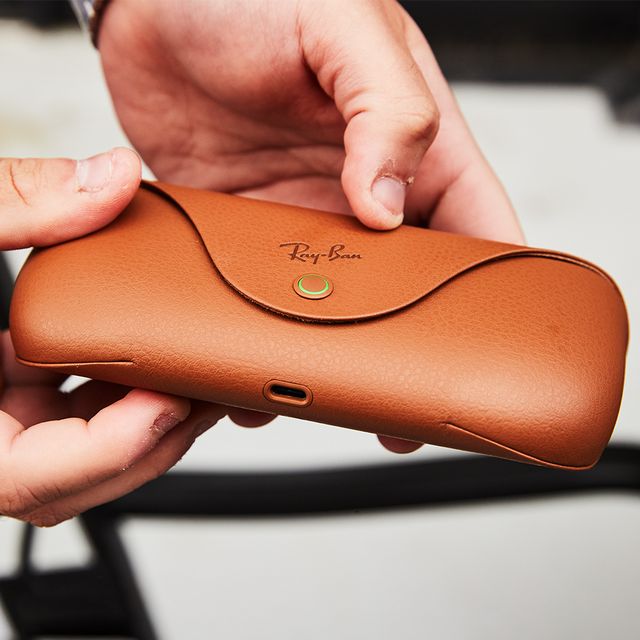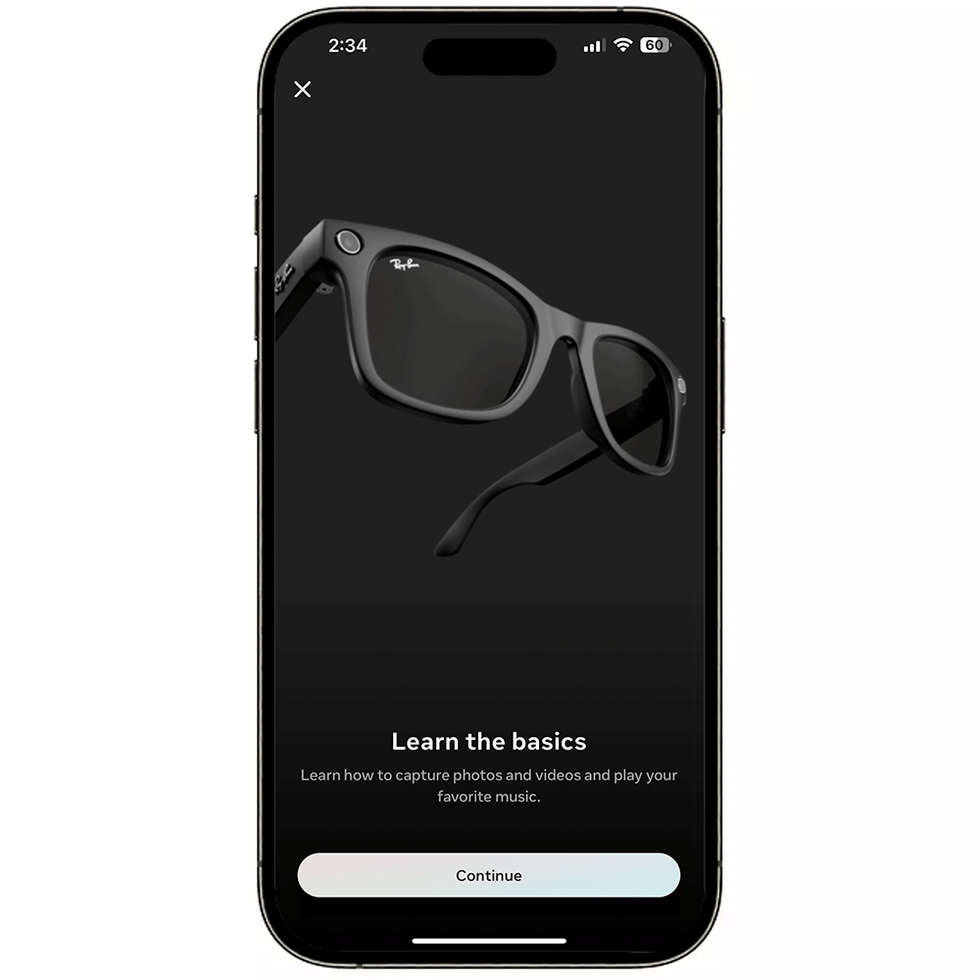It’s been two years since the Ray-Ban Stories smart glasses made a debut. That $299 gadget combined speakers, cameras, and microphones in a stylish pair of shades that could capture photos and video, as well as serve as a pair of wireless headphones. They were not AR-display enabled, but were a first step toward taking the smart glasses category mainstream. Unfortunately Ray-Ban’s Stories struggled to find footing and owners eventually stopped using due to wonky battery life and limited memory for captures. But after spending a full week creating content with the next generation of this wearable (renamed to Ray-Ban Meta Smart Glasses), I found the hardware is an improvement on the original concept in every way—and it still starts at $299.
Shots are sharper thanks to a higher resolution camera, the audio is louder with satisfying bass, and a new onboard conversational AI makes them smarter than ever before. With its streamlined import system and improved battery life, this new version showcases just how handy it can be to have a wearable action camera and wireless headphones at the ready. They are still content-creation focused with a new live streaming feature locked to Meta’s social media platforms. However, the audio performance and AI abilities of these new smart glasses go beyond a novelty and will appeal to more people.
Tear open the box and you’ll find the smart glasses nestled away in a the signature tan soft leather case that comes with a normal set of Ray-Bans. This serves as both portable storage and a charging dock. It’s much more compact than the hard black case that came with the first generation glasses and provides eight full charges for up to 36 hours of juice. My review pair came with polarized lenses which makes for better contrast and reduced glare but raised the price up to $329. As a pair of sunglasses alone, they’re comfortable and do an excellent job blocking the sun—in the picture below I placed them side by side with my everyday Ray-Bans that I’ve had for over a decade. Of course they’re slightly heavier due to the tech components, but overall they don’t feel as toy-like as the first edition—think more a functional set of shades first with impressive gadget features second.
Aesthetically, the slimmed down fit and water resistant IPX4 rating are essential for something you’ll wear all day. They weigh less, fit better (especially noticeable in weight on the back of your ears and nose), and are tougher built than the Stories. With the Ray-Ban Stories, your options were limited to pre-made configurations with shiny toy-like bodies and styles. Now you can customize transparent arms to show off the tech, make a colorful pair of lenses, and even add prescription lenses with over 150 combinations with Ray-Ban Remix platform on the site.
Tucked in the back of the package you’ll find a USB-C cable and a QR code, which directs you to the Meta View App Store page. After the app is installed, you just have to sign in and pair the glasses through the “add new device” function in the top-right corner. The snap closure button on the front of the case has LED lights to indicate status and charge levels. These glow blue while pairing the glasses with your phone. The app shows you how to use the functions like touchpad controls and services. After this is done you can connect apps like your phone notifications, so you can get calls and text read aloud, or enable Spotify Tap so you can play music with a touch. I found this particularly helpful to kick off a mix during workouts and walks.
Unlike its predecessor the Ray-Bans feature a beastly Snapdragon AR1 Gen 1 processor for advanced picture and video processing, as well as enough computing power to support onboard conversational AI. You can ask it to play music, take an action, or answer a question seamlessly. No, we’re not talking simple voice commands—Meta’s full scale generative AI is a game changer that can control actions and answer questions while remaining aware of topics. For example, as I lounged on the beach I asked the glasses, “Hey Meta, give two ways to help me fall asleep,” which it answered in full detail with tricks and progressive muscle relaxation techniques. I then followed up with, “Hey Meta, give me three more ideas,” and it remembered my previous query to continue its response. The biggest potential I see with the generative AI is messaging. I frequently used AI to write up thoughtful responses on Facebook Messenger as well as write witty social captions for my Instagram stories. And with improved microphone array, the glasses accurately recognized the Hey Meta keyword in wind, inside stores, and even on a subway train. Next year, the glasses will be connected to an updated AI model that can answer real-time questions like the live score of a baseball game. And in the future, Meta AI will use the built-in camera to identify what you’re looking at for visual search and identification.
This powerful AI paired with a newly refined sound performance is the “killer app” for these smart glasses as they have a tangible everyday benefit beyond the cameras. Like its predecessor, the Meta Ray-Ban Smart Glasses speakers employ an open-ear audio system that plays out of the temple arms. Bass on the new glasses is so much heavier that you can feel a slight kick which speaks to its power. These glasses tend to get pretty loud at just 50 percent volume. While they aim to keep you present in your surroundings, the audio is immersive at maximum volume and virtually eliminated the loud hum of a window unit air conditioner in my office. The sound improvements from the first generation glasses are drastic. Side-by-side with the originals, I not only made out riffs better but also could hear backing details like vinyl crackles, underlying drums, and backing vocals that were entirely missing on the Stories. Meanwhile voices from phone calls and podcasts sound fuller and more lifelike.
Despite a slimmer profile, there are more microphones—five to be exact. With the new glasses, my voice in calls and recordings sounds as clear as if it’s actually in the room—the first version sounded tinny and distant. But these extra microphones also come in handy for capturing spatial audio. You can now hear where sound comes from in video captures. Whether it’s the voice of someone circling around you or the waves of the ocean this effect pronounces exactly where noise comes from. The new glasses also have redesigned speakers to keep audio private to your ears, but there is some volume leak once you surpass 60 percent loudness. Most times you won’t, though, since that’s plenty loud. But, if you crank them, the person sitting next to you in the office or on the train will be able to make out what you’re listening to.
To shoot photos or record video, the capture process has flipped from the first-gen stories. Instead of holding down the button to shoot a still image you simply click it on Gen 2. You can see how much sharper the 12MP ultra wide stills (3024 by 4032 pixels) on the new Ray-Ban Meta smart glasses look in comparison to the originals 5MP (2592 by 1984 pixels) in the gallery below. Object textures like a dog’s fur or the pores of rocks look especially sharp with less noise. While they look best during the day or overcast conditions, even low-light captures have greatly improved. You can see how much more color and detail the new glasses can extract, which is clear in the nighttime shot of the Halloween decorations in the gallery. Granted, shots won’t look as good as something you took with a phone’s camera, but they are fine for social media posts. Hold down the capture button to record enhanced video at 1080p for up to 60 seconds. Recordings are much cleaner and the built-in stabilization in footage I captured while running or climbing up stairs is much smoother rather than the bobbing and weaving the original Stories suffered from. Plus you can record more footage with eight times the storage space of the first generation smart glasses.
Once you’ve captured your content and are ready to send it to the app, it’s no longer a hassle to share. You can simply shoot or record, then post your capture with the press of a button. There’s no need to download the clip, resize it, then share it to your account. The Ray-Ban Meta glasses have a new ability to livestream directly to Meta platforms. You can start a live video and hand off the camera angle between your phone and glasses with a click. Its quality is automatically determined by your service but, even with one 5G bar, my experiences didn’t feel laggy or grainy. I’m no influencer, so I found the drip of comments that were read aloud while I streamed just right without being confused about which viewer said what. But streamers who use platforms outside of the Meta ecosystem like Twitch, TikTok, and YouTube and could stand to benefit from a pair of live-streaming glasses are left out in the cold.
Battery life has slightly increased which is noticeable on days when you take a bunch of captures. On a normal day, when I’m intermittently listening to music at 25 percent volume, snapping the occasional 15-second video, and taking a photo or two every hour, the glasses easily last more than five hours. And when they die, I pop them into the easy to carry soft case in my pocket and charge them fully in just one hour. I continuously have Spotify rolling through my liked songs, ask Meta’s AI to write out my responses, and record videos for my Instagram stories, yet can make it from lunch to the end of the workday with the glasses sitting on my face. This staying power is a stark contrast to last generation’s glasses, which often passively depleted on me to the point where I only get around three or so hours of constant use these days.
When standard Ray-Ban Wayfarers go for $199, the smart glasses $299 starting price gives you a lot of bang for your buck. These are comfortable, easy-to-use, and last all day. Beyond the hardware improvements, the addition of AI brings a whole new set of tools to enhance your everyday tasks. Even if you aren’t a content creator who constantly shares social media posts, the Ray-Ban Meta smart glasses are worth checking out for their ability to capture your everyday memories, plus the sound performance and controls the AI delivers.
Test Editor
Hunter Fenollol, our resident expert of all things consumer tech, from smart home to VR gaming headsets, has years of knowledge creating product explainers, in-depth reviews, and buying guides to help you get the most from the latest electronics. Throughout college, he covered and reviewed the latest gadget releases for sites like Tom’s Guide, Laptop Magazine, and CNN Underscored. If he’s not elbow-deep in the latest hardware, you can find Hunter at one of Long Island’s many beaches, in Manhattan, or gambling away his paycheck.
"gadget" - Google News
October 19, 2023 at 12:41AM
https://ift.tt/l0naKBh
Ray-Ban Meta Smart Glasses | Gadget Reviews - Popular Mechanics
"gadget" - Google News
https://ift.tt/ahekDsb
Bagikan Berita Ini
























0 Response to "Ray-Ban Meta Smart Glasses | Gadget Reviews - Popular Mechanics"
Post a Comment